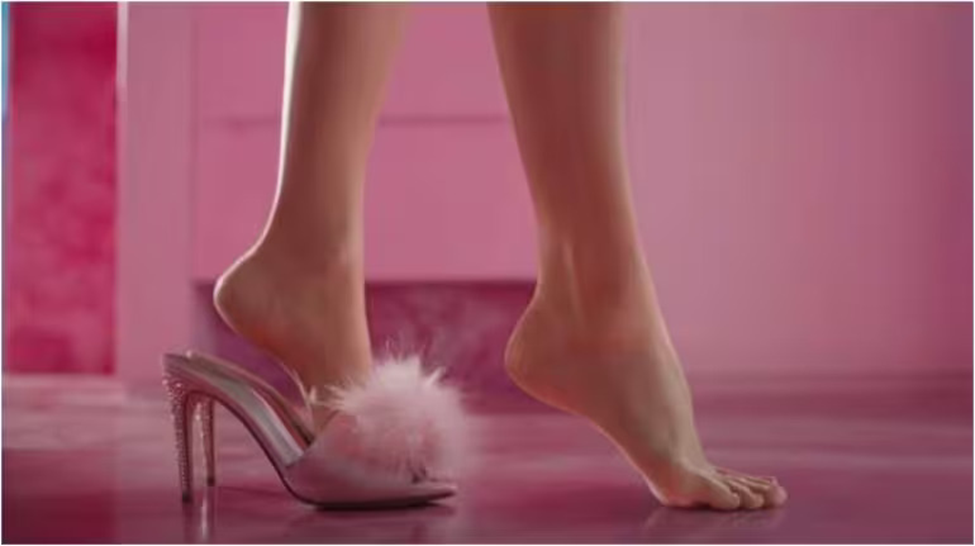What is Barbie Feet Challenge?
The world is currently swept up in the ‘Barbie’ craze, and one intriguing manifestation of this craze is the TikTok fad known as the “Barbie Feet Challenge,” which has garnered an astounding 80 million views!
Inspired by Margot Robbie’s iconic Barbie stance – walking on tiptoes after getting out of her pink sparkly heels, TikTok users worldwide couldn’t resist joining the “Barbie Feet Challenge”.
While the trend appears harmless fun among the masses, medical experts hold a different perspective on its potential risks. Let’s delve into the fascinating world of the Barbie Feet Challenge and explore the concerns raised by doctors.
Why are Doctors Advising Against It?
Dr Jodi R. Schoenhaus, a board-certified podiatrist at the Foot, Ankle & Leg Vein Center, in an interview with the Post, cautions that while the Barbie Arch can visually elongate and tone a woman’s legs, it is not entirely risk-free. She advises that attempting the pose once or twice for a TikTok video is unlikely to cause harm, but there are potential risks associated with frequent or improper execution.
She mentions that attempting the high-arched pose and walking on tiptoes for extended periods involves certain risks. The ankle instability in this position can lead to ligament sprains and injuries commonly associated with high heel use.
In addition to potential ankle issues, the high-arched pose can also strain the lower back, leading to muscle and spine problems. This particularly concerns young girls who are still growing, as it can damage their growth plates.
Moreover, walking on tiptoes without heels is not sustainable for most individuals, and it’s worth mentioning that Barbie herself, as portrayed in the movie, actually has flat feet, which, according to a study shows, is a common condition among 26.5% of the population.1 Considering that most of us are not trained ballerinas en pointe, it’s best to leave this fad to movie stars with props, and multiple takes to achieve the perfect look.
According to Emily Scott, an Allegheny County Medical Society member and a Direct Care Physician in Pittsburgh, repetitive attempts at the Barbie Arch pose can lead to potential health issues like bunions, neuromas, and stress fractures. This is especially true for individuals who are not accustomed to bearing their weight on their toes.
Scott further adds, “The higher the heel, the more difficult it is to distribute your weight off your toes and onto your heels. Make sure to maintain a good range of motion in the ankle by bringing the foot up, also known as dorsiflexion. This will prevent injuries such as Achilles tendinitis. Avoid high heels with a very narrow toe box which will squeeze your toes together even more, leading to an increased risk of hallux valgus, hammer toes, and Morton’s neuroma.”
What are the Possible Risks?
Wearing high heels for extended periods can increase the risk of various foot problems such as hallux valgus (bunions), tailors bunions, hammer toes, stress fractures (especially with heels higher than 3 inches), plantar fasciitis, and Morton’s neuromas, which involve painful nerve compression between the toes.2
Despite their stylish appeal for special occasions, prolonged wear of high heels can lead to degenerative foot problems and persistent discomfort while walking in later life.3
Moreover, while filming the Barbie Feet Challenge, Margot Robbie mentioned using a support bar and taping her heels to the ground for stability. However, many TikTok participants skip these precautions, increasing the risk of potential health issues.
Is It Worth the Hype?
It’s important to note that wearing heels and performing the Barbie Foot pose is not the same. While the foot may be in a similar position, heels provide support to the heel and rear of the foot, whereas the Barbie Foot has no support at all, putting additional strain on the body.
In a nutshell, rocking those pink stilettos for a few minutes for a viral trend or while stepping into the theatre for the latest Barbie Movie is one thing, but wearing high heels and walking on your tiptoes for prolonged periods is nothing short of a footsie faux pas!
So ladies! go with the trend, strike a pose, and have your moment, but when it comes to everyday wear, let’s give our feet the love and comfort they deserve.
References:
- Pita-Fernandez S, Gonzalez-Martin C, Alonso-Tajes F, Seoane-Pillado T, Pertega-Diaz S, Perez-Garcia S, Seijo-Bestilleiro R, Balboa-Barreiro V. Flat foot in a random population and its impact on quality of life and functionality. Journal of clinical and diagnostic research: JCDR. 2017 Apr;11(4):LC22.
- Mayo Clinic. Plantar fasciitis. (Accessed: August 01, 2023) Available at: https://www.mayoclinic.org/diseases-conditions/plantar-fasciitis/symptoms-causes/syc-20354846#:~:text=Plantar%20fasciitis%20is%20an%20inflammation,common%20causes%20of%20heel%20pain.
- American Orthopaedic Association. The Real Harm in High Heels. (Accessed: August 01, 2023) Available at: https://osteopathic.org/what-is-osteopathic-medicine/the-real-harm-in-high-heels/




